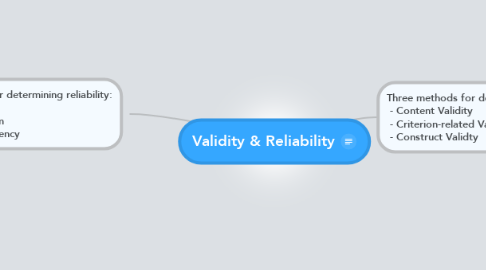
1. Three methods for determining validity: - Content Validity - Criterion-related Validity - Construct Validty
1.1. Content Validity
1.1.1. Do test questions correspond to what should be covered by the test?
1.1.2. Easiest to determine if test is in an area such as achievement
1.1.3. Gives information is test "looks" good
1.1.4. Answers the question, "does the test measure the instructional objectives"
1.1.5. Difficult to determine if what is tested is personality or aptitude trait
1.1.6. Does not give information if items are poorly constructed
1.2. Criterion-related Validity
1.2.1. Concurrent
1.2.1.1. Deals with measures that can be administered at the same time as the measure to be validated
1.2.2. Predictive
1.2.2.1. Refers to how well the test predicts some future behavior
1.2.3. Yields a numeric value
1.3. Construct Validity
1.3.1. Exists if the test's relationship to other information corresponds well with some theory
2. Three methods for determining reliability: - Test/Re-test - Alternative Form - Internal Consistency
2.1. Test/Re-test
2.1.1. Correlation between first test scores and second test scores
2.1.1.1. Higher the correlation, the greater the reliability
2.1.2. There is usually some memory or experience involved in the second time test is given
2.1.2.1. Overcome by using a longer interval between test administrations
2.2. Alternative Form
2.2.1. Two equivalent forms of the test are administered to same population
2.2.2. Eliminates the problems of memory and practice found with test-retest approach
2.2.3. Each form must be administered in the same or similar conditions
2.2.4. Time to develop two "good" tests takes extensive time and resources
2.3. Internal Consistency
2.3.1. Depends on the entire test consisting of similar items measuring a single concept
2.3.2. Inflated estimates can occur if the test consists entirely of easy or relatively easy item tasks within a strict time limit (speeded test)
2.3.3. Types
2.3.3.1. Split-half Methods
2.3.3.1.1. Single test, divided into two shorter alternative forms
2.3.3.1.2. Only one test is created - time and resources not doubled
2.3.3.2. Kuder-Richardson Methods
2.3.3.2.1. Depends on the extent to which the entire test represents a single, fairly consistent measure of a concept
2.3.3.2.2. Yields reliability estimates lower than those of split-halves, but higher than test-retest or alternate-form estimates
